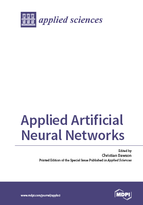Applied Artificial Neural Network
A special issue of Applied Sciences (ISSN 2076-3417).
Deadline for manuscript submissions: closed (31 March 2016) | Viewed by 73898
Special Issue Editor
Interests: environmental modelling; artificial neural networks; rainfall-runoff modelling; sports performance analysis
Special Issues, Collections and Topics in MDPI journals
Special Issue Information
Dear Colleagues,
Since their re-popularisation in the mid-1980s, artificial neural networks have seen an explosion of research across a diverse spectrum of areas. While an immense amount of research has been undertaken in artificial neural networks themselves—in terms of structures, training algorithms, topologies, types, etc.—an equally large proportion of work has examined the application of neural networks to a whole host of problems. Such problems are usually difficult to define and hard to solve using conventional techniques. Examples include computer vision, speech recognition, financial applications, medicine, meteorology, robotics, etc.
This Special Issue focuses on the second of these two research themes—that of the application of neural networks in diverse range of fields and problems. Papers are solicited that discuss the application of artificial neural networks. Discussion should include critical comparisons with existing techniques, modifications to neural networks, and in depth interpretation of results.
Dr. Christian Dawson
Guest Editor
Manuscript Submission Information
Manuscripts should be submitted online at www.mdpi.com by registering and logging in to this website. Once you are registered, click here to go to the submission form. Manuscripts can be submitted until the deadline. All submissions that pass pre-check are peer-reviewed. Accepted papers will be published continuously in the journal (as soon as accepted) and will be listed together on the special issue website. Research articles, review articles as well as short communications are invited. For planned papers, a title and short abstract (about 100 words) can be sent to the Editorial Office for announcement on this website.
Submitted manuscripts should not have been published previously, nor be under consideration for publication elsewhere (except conference proceedings papers). All manuscripts are thoroughly refereed through a single-blind peer-review process. A guide for authors and other relevant information for submission of manuscripts is available on the Instructions for Authors page. Applied Sciences is an international peer-reviewed open access semimonthly journal published by MDPI.
Please visit the Instructions for Authors page before submitting a manuscript. The Article Processing Charge (APC) for publication in this open access journal is 2400 CHF (Swiss Francs). Submitted papers should be well formatted and use good English. Authors may use MDPI's English editing service prior to publication or during author revisions.
Keywords
- Machine Learning
- Artificial Neural Networks
- Applications
- MLP
- RBF
- SVM
- Deep learning
- Data Mining
- Vision
- Robotics






